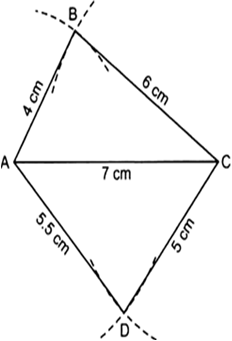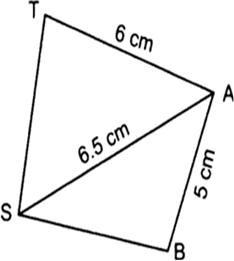Sponsor Area
Practical Geometry
Construct a quadrilateral ABCD when AB = 4 cm, BC = 6 cm, CD = 5 cm, AD = 5.5 cm and AC = 7 cm.
First of all make a rough sketch. Do not start construction without drawing a rough sketch showing sides, angles and diagonals, etc., with correct name.
Step I. Draw a rough sketch and mark the measurements.
Step II. Draw AC = 7 cm.
Step III. With A as centre and radius 4 cm, draw an arc above AC.
Step IV. With C as centre and radius 6 cm, draw another arc intersecting the previous arc at B.
Step V. With centre A and radius 5.5 cm, draw an arc below AC.
Step VI. With centre C and radius 5 cm, draw another arc to intersect the previous arc at D.
Step VII. Join DA and DC.

Thus, ABCD is the required quadrilateral.
Arshad has five measurements of a quadrilateral ABCD. These are AB = 5 cm, ∠A = 50°, AC = 4 cm, BD = 5 cm and AD = 6 cm. Can he construct a unique quadrilateral? Give reasons for your answer.
Solution not provided.
We saw that 5 measurements of a quadrilateral can determine a quadrilateral uniquely. Do you think any five measurements of the quadrilateral can do this?
No, any 5 measurements (elements) cannot determine a quadrilateral. Actually to construct a quadrilateral, we need a specific combination of measurements such as:
(a) Four sides and one diagonal.
or
(b) Three sides and two diagonals.
or
(c) Two adjacent sides and three angles.
or
(d) Three sides and two included angles.
or
(e) Some special properties are given.
Can you draw a parallelogram BATS where BA = 5 cm, AT = 6 cm and AS = 6.5 cm? Why?
Let us draw a rough sketch of BATS as given.
Here, we cannot locate the points T and B without knowing the measurements ST and SB respectively.
Thus, we cannot draw a parallelogram with the given measurements.
Sponsor Area
Mock Test Series
Mock Test Series





